

July 2015
IN THIS ISSUE:
![]()
- Chinese leaders gather with U.S. health officials, visit Clinical Center
- Advances made in diagnosing coronary heart disease
- NIH staff and patients record history with StoryCorps
- South African researchers benefit from Clinical Center expertise
- Clinical Center staff updates
- Helping to make NIH the National Institutes of Hope for 25 years
- The summer market brings goods to the CC and Bldg 31
- Stakeholders gather in the CC to chart the future of sickle cell disease research, engages the community in developing solutions
- Decker Memorial Lecture showcases cardiovascular risk, insulin resistance
- Employees participate in Take a Hike Day event on campus
- Volunteers needed for clinical trials on asthma, taste, vascular health
- Upcoming Events
Print this Issue ![]() (496 KB)
(496 KB)
ABOUT CC NEWS:
![]()
Published monthly by the Office of Communications and Media Relations. News, article ideas, calendar events, letters, and photographs are welcome. Submissions may be edited.
Clinical Center News
National Institutes of Health
Building 10, 10 Center Drive
Room 6-2551,
Bethesda, MD 20892-1504
Tel: 301-594-5789
Fax: 301-402-0244
Molly.hooven@nih.gov
QUICK LINKS:
![]()
Chinese leaders gather with U.S. health officials, visit Clinical Center
 |
Experts at the NIH Clinical Center provide a demonstration to Lin Bin, (fifth from right) the minister of China's National Health and Family Planning Commission, on technology that can assist and strengthen patients' movement abilities. |
Chinese Vice Premier Liu Yandong and Li Bin, minister of the National Health and Family Planning Commission of the People's Republic of China, visited NIH June 24 and joined Sylvia Burwell, secretary of the Department of Health and Human Services (HHS), Jimmy Kolker, assistant secretary for global affairs at HHS and NIH officials for a bilateral meeting on Ebola, research and global health security.
The officials were in Washington, D.C., for the sixth China-U.S. High-Level Consultation on People-to-People Exchange. This year marked the first time 'health' was on the meeting agenda.
During the visit, on behalf of the Centers for Disease Control and Prevention, which is a component of HHS, Secretary Burwell signed a memorandum of understanding with Minister Bin to promote closer cooperation, scientific discovery, capacity building and exchange of information in the field of infectious diseases.
 |
Sylvia Burwell, secretary of the Department of Health and Human Services, joins China's Vice Premier Liu Yandong (center) and the minister of China's National Health and Family Planning Commission Lin Bin in signing a memorandum of understanding on infectious diseases. |
Bin also visited Building 10. Dr. Francis Collins, director of NIH, along with Dr. John I. Gallin, director of the Clinical Center, gave an overview of the research hospital and escorted the guests to the Rehabilitation Medicine Department's Clinical Movement Analysis Lab.
The visitors watched Abhinav Sharma (pictured above on the treadmill), a NIH post-baccalaureate fellow, demonstrate a newly-designed motorized 'smart' robotic exoskeleton. Dr. Zach Lerner (pictured above, left of Sharma), a post-doctoral fellow, explained how the exoskeleton is designed to help children with cerebral palsy improve their ability to walk. The technology assists children who walk with excessive knee flexion, or crouch, by enabling them to have a more upright stride.
Advances made in diagnosing coronary heart disease
 |
More than 200 men and women participated in the Clinical Center study related to coronary artery disease, the most common type of heart disease. The picture above (left) is of a 62-year-old man's coronary tree, or the components of the artery that bring blood to the heart. In the middle is a curved reconstruction of the left anterior descending artery, a part of the left coronary artery that supplies blood to the left side of the heart. Here you can see the external vessel walls that experts were analyzing for plaque buildup. On the right are representative cross-sectional images of the artery. The top right shows calcified plaque, and the bottom right shows non-calcified plaque. In addition to the calcified buildup of hard plaque, the rupture of non-calcified, or soft, plaque can also be directly related to heart attack. |
Experts at the NIH Clinical Center recently published findings in the Radiological Society of North America that could help healthcare professionals better identify, diagnose and treat coronary artery disease more quickly and effectively. The disease accounts for 17 million deaths a year.
Over time, coronary arteries, which supply blood to the heart muscle, can develop a buildup of plaque that hardens and eventually calcifies. Plaque in the coronary arteries can narrow the coronary arteries and rupture, reducing the flow of oxygen-rich blood to the heart.
An indicator of the calcification of the heart's arteries can be seen through a coronary artery calcium score from a computed tomography (CT) scan. However, plaque that is still non-calcified, or soft, is not included in that score. NIH Clinical Center researchers believed that this type of plaque could also indicate an increased risk for the disease. And they were right.
When researchers compared the calcium score of the hardened plaque versus the non-calcified soft plaque, they found significant differences. Non-calcified plaque that had not hardened yet was associated with the bad type of cholesterol (LDL), diabetes and systolic blood pressure. These variables were not associated with the calcium score in low-risk, asymptomatic individuals. Age was also a strong predictor of the calcium score, but not of non-calcified soft plaque buildup. These results suggest that analyzing the different types of plaque, both hard and soft, gives more information about the risk of coronary artery disease than just the calcium score.
"Calcium score by CT scan is related to cardiac risk, but does not fully represent the amount of disease that is present," said Dr. David A. Bluemke, director of Radiology and Imaging Sciences at the Clinical Center. "Soft plaque identified by taking pictures of the heart's blood vessels using CT angiography was more closely related to risk factors in these low to moderate risk individuals."
This new method of relying upon plaque analysis and not just coronary artery calcium score of hardened plaque shows promise as a tool for quantifying the total plaque burden. With a more complete look, healthcare professionals will be able to diagnose and treat coronary artery disease in a timelier manner, with greater success.
NIH staff and patients record history with StoryCorps
 |
After their recording session ended, Sheryl Zwerski (left) joked with Elizabeth Flannagan (right) that they should title their conversation 'guts and grace'. |
A StoryCorps airstream trailer and mobile booth traveled to the NIH Clinical Center May 27-29 and June 4-6 to record and preserve voices of the community as part of a national oral history project.
Patients, families, researchers, doctors, nurses, staff, volunteers and many other partners in the NIH mission recorded a 40-minute conversation with a partner. Participants took home a broadcast-quality CD of the conversation and the recording is also archived at the Library of Congress and with the NIH.
Elizabeth Flanagan and Sheryl Zwerski, both NIH employees who work for the National Institute of Allergy and Infectious Diseases, participated in the May recording session. Zwerski asked Flanagan about facing stage 4 colon cancer at the age of 36 and how working with people who are living with HIV had prepared Flanagan to face her own illness.
"NIH has been the best place for the worst things to happen," Flanagan said. "I spent my career working with people living with HIV, often newly-diagnosed, and telling them, while they had a life-threatening, life-limiting illness, they could manage it and still live life to the fullest. How could I not take my own advice?"
In the months to come, the NIH will select stories to be integrated into the NIH Visitors Center experience or made available to the public in other ways, such as in public presentations or through the NIH website. StoryCorps was last at NIH in December 2014.
South African researchers benefit from Clinical Center expertise
Experts from the Department of Health and Human Services, under the leadership of Clinical Center Director Dr. John I. Gallin, traveled to South Africa in May to share clinical research best practices with local scientists. The Clinical Center's experience in teaching the principles of clinical research was the key component in this educational exchange.
"It was special to have an opportunity to bring our Clinical Center course to South Africa and to interact with faculty and students from that part of the world," said Gallin. "Our hope is that the South Africans will use this experience to establish their own course for the future."
The U.S. faculty presented an intensive version of the Introduction to the Principles and Practice of Clinical Research course at the South African Medical Research Council headquarters in Cape Town.
This educational endeavor was the latest in a number of NIH collaborative efforts in South Africa and was supported by the Fogarty International Center. In 2013, the South African Medical Research Council and the NIH entered into an agreement to expand collaboration between scientists in biomedical and behavioral research in both nations.
Over the last two years, several projects have been organized, including a joint research summit on HIV/AIDS and tuberculosis held in Durban; a grant writing workshop held in Johannesburg and a series of seminars held in Pretoria, Durban and Cape Town to prepare for a five-year, multi-million dollar grant jointly-funded by the South African Medical Research Council and the NIH.
The clinical research educational program was the latest session of the Clinical Center course hosted overseas. Previous courses have been held in Brazil, China, India, Nigeria and Russia. This year's program hosted 78 participants in South Africa, with eight of the students attending from Kenya, Uganda, Zimbabwe and Tanzania.
"South Africa is one of the brightest stars of clinical research in Africa," said Dr. Frederick P. Ognibene, deputy director for Educational Affairs and Strategic Partnerships and director of the Clinical Center's Office of Clinical Research Training and Medical Education. "This collaborative effort is a part of the NIH and Clinical Center's mission to provide training and support clinical research."
The course is offered annually at the Clinical Center from October through March.
 |
In an effort to share clinical research best-practices with the world, experts from the NIH traveled to South Africa to train and support rising scientists and researchers. |
Clinical Center staff updates
Chief of Social Work Department retires after 20 years of service
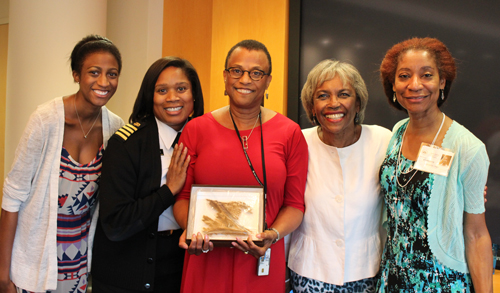 |
Adrienne Farrar retired as chief of the Clinical Center Social Work Department in July. Farrar, surrounded by friends, holds the 'dirt award' showcasing dirt saved from the groundbreaking ceremony for the Mark O. Hatfield Clinical Research Center in 2004. |
After 20 years serving as the chief of the Clinical Center's Social Work Department, and 30 years as a leader in the field of medical social work, Dr. Adrienne Farrar retired July 3.
Her unwavering leadership has led the Social Work Department to major accomplishments within the Clinical Center, including the establishment of a robust volunteer program and interpreter services, including the implementation of remote phone interpretation program and a streamlined process for research teams to use local and on-site interpreter services for the diverse population of patients.
Farrar spent her career actively involved at the local and national levels in developing continuing education programs for social workers throughout the region and the country. While always remaining focused on the Clinical Center's Social Work Department, she also was attentive to the needs of the larger social work community. She is a member of the National Association of Social Workers, a board member of the Association of Healthcare Social Workers – Metro DC, Inc. and a member of the National Society for Social Work Leadership in Health Care.
"I've enjoyed my time at the Clinical Center leading an amazing department and team of professionals dedicated to the Clinical Center and NIH mission," said Farrar. "I look forward to seeing the continued progress of such a talented group of people in a special center at the NIH."
Farrar has led a cadre of over 20 licensed social workers who provide psychosocial services to patients who come to the Clinical Center from all over the country and the world. The Clinical Center is in the process of recruiting a new chief of the department.
Laura Cearnal retires, Antoinette Jones new patient representative
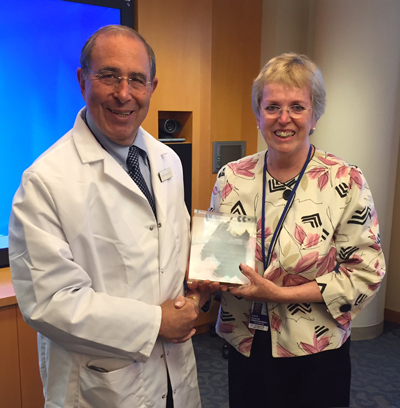 |
Dr. John I. Gallin, director of the Clinical Center, presented a 'dirt award' to Laura Cearnal who retired in May as patient representative. The award includes dirt saved from the groundbreaking ceremony for the Mark O. Hatfield Clinical Research Center in 2004. |
In late May, Laura Cearnal, the Clinical Center Patient Representative, retired after 16 years of service. Cearnal worked with staff and patients, handling all concerns, issues and complaints related to any aspect of the patient experience at the NIH.
In an email, Dr. John I Gallin, director of the Clinical Center, said "As a former nurse manager in the Clinical Center, Laura brought with her to this position the insights and skills of a seasoned clinician. She coupled these skills with a compassionate human understanding that served to comfort and support our patients as they called upon her for assistance. Laura's service ... set a high standard of quality and service which will long be remembered."
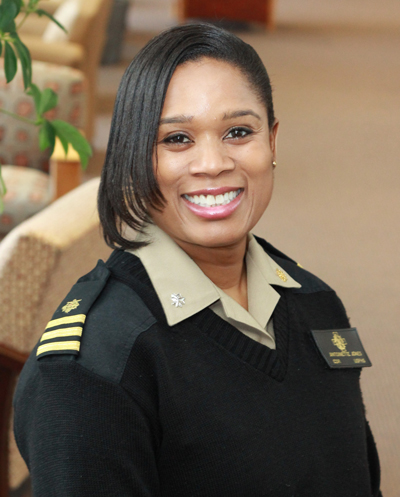 |
CAPT Antoinette Jones has been selected as the new patient representative. |
After a wide search, CAPT Antoinette Jones has been selected as the new patient representative. Jones, who joined the United States Public Health Service Commissioned Corps in 2005, has extensive education in executive coaching, business and leadership.
Jones has served the Clinical Center as operations manager for the Department of Radiology and Imaging Sciences where she ensured excellence in service and safety for patient undergoing imaging exams and procedures. Prior to that, she worked in the Clinical Center's Office of Workforce Management and Development and Nursing Department. She was also a graduate oncology nurse with the National Cancer Institute.
To reach the patient representative, email aljones@cc.nih.gov.
Helping to make NIH the National Institutes of Hope for 25 years
A place where hope is fostered, unbreakable bonds are created and a love for life is cherished – The Children's Inn at NIH celebrated its 25th Anniversary with a symposium in the Clinical Center June 18.
The symposium is just one of many events that will take place throughout the year to commemorate the Inn's anniversary and important role in empowering the work of NIH clinicians and researchers.
Physicians, patients and their families along with long-time supporters of the Inn gathered to share the progress made in treating and curing many diseases that strike children and teenagers, patient's personal stories of triumph, and to highlight the rich history of the Inn and its integral role in supporting the next 25 years of medical discovery.
The Children's Inn at NIH has been the home away from home for many children being treated at the Clinical Center and their families. The non-profit organization houses patients who are enrolled in pediatric protocols and their families. Patients range in age from infants through age 25. For a quarter of a century, it has helped soften the hardships that families go through emotionally and financially while seeking medical care.
Staff recalled a time when The Children's Inn at NIH did not exist, and they would see families sleeping in their cars, parents being separated from their children and meals taken from the vending machines. With the help of generous supporters, board members, staff and volunteers, it has become a place where families can rejoice, relax and release.
Ben Banks, a former patient at the Clinical Center and resident of the Inn, shared his remarkable story that began in 1981 when he was diagnosed stage 5 Wilm's tumor, a rare kidney cancer, at two-years-old. Outside the NIH, he had two surgeries each requiring blood transfusions and 15 months of chemotherapy and radiation therapy which caused his blood platelet count to get so low that he started bleeding through the pores on his hands, his face and his feet.
Ten years later, Banks remained cancer free but received the 'numbing' news that he was HIV Positive. He quickly enrolled in an Interleukin 2 protocol at the NIH Clinical Center.
"I had to face the fact that one of my blood transfusions I received that saved my life from cancer was tainted with HIV", he shared. "That protocol – it tested you. It really made sure that you're dedicated to being a patient that you're going to be on that study to not only learn what it would do for you but that it would unlock the doors to find answers for others. The Inn provided me with hope for the future and medicine has made it possible for me to have a family."
Patients such as Banks have helped experts at the NIH develop tests to detect AIDS/HIV and hepatitis viruses in blood, which led to a safer blood supply.
Another patient of the Clinical Center, Isaac Barchus, was diagnosed with Chronic Atypical Neutrophilic Dermatosis with Lipodystrophy and Elevated Temperature (CANDLE) Syndrome, a rare autoinflammatory disease, at just two-weeks-old. He was the first patient with this condition to be treated at the NIH Clinical Center. His mother, Kathe joked with the audience that Isaac, who was very ill and consequently very grumpy, 'broke the hearts' of a few doctors because when they asked Isaac what they could do to make him feel better, he exclaimed that all he wanted to do was "just play bingo at The Children's Inn."
While it took years, Barchus, and eventually other patients with CANDLE, have helped researchers accumulate a small group of patients and develop functional studies to learn more about the syndrome.
View many more stories and highlights of the event: http://videocast.nih.gov/launch.asp?19076
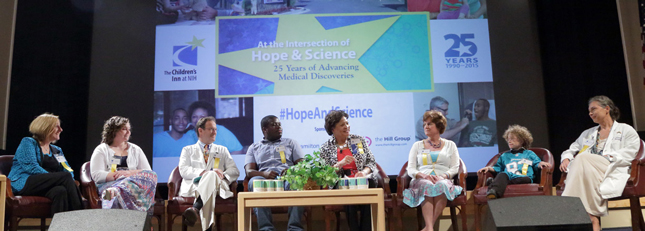 |
Patients, staff and other supporters of The Children's Inn at NIH, a non-profit organization, attended an anniversary symposium June 18 in the Clinical Center. |
The summer market brings goods to the CC and Bldg 31
The Recreation and Welfare Community Market [disclaimer] will take place outside the south entrance to the Clinical Center on Tuesdays from 10 a.m. – 2 p.m. The market offers plants, flowers, breads, cookies, pound cake, frozen crab meat, filet mignon, steaks, canned nuts, crab dips, marinara, salsa, soups, chocolates, popcorn, pickles, cupcakes, extra virgin olive oil, barrel-aged wine vinegars, balsamic vinegars, goat cheese and bottled tea. Rotating food trucks will also be available. |
Stakeholders gather in the CC to chart the future of sickle cell disease research, engages the community in developing solutions
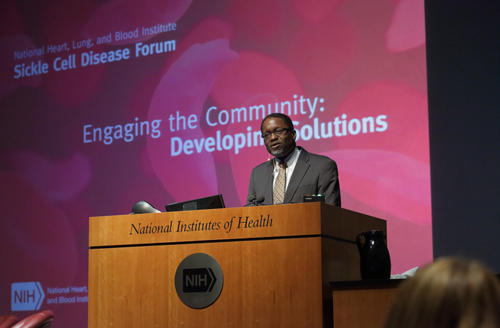 |
Dr. Gary Gibbons, director of NHLBI, opened the sickle cell disease research forum in late June. |
The National Heart, Lung, and Blood Institute (NHLBI) hosted a forum on sickle cell disease titled "Engaging the Community: Developing Solutions," June 25 and 26 in the Clinical Center.
Sickle cell disease is a blood disorder that prevents the normal delivery of oxygen throughout the body. In 1973, the life expectancy of an individual with the disease was just 14-years-old, but with continuous research advances, people now have a life expectancy range of 40 to 60-years-old.
Dr. Gary Gibbons, director of NHLBI, opened the forum and specifically addressed the patients in attendance.
"We are looking for opportunities to listen to your voice about helping us set a research agenda," said Gibbons. "What better experts to consult than patients and families that are affected by this disease. You are a part of our circle of partners. We are connected together."
Gibbons also stressed the importance of community and commitment in the effort to help people with sickle cell disease. The information gathered at the forum will be used to help NIH and its partners further the research on the disease in hopes to find a cure.
Decker Memorial Lecture showcases cardiovascular risk, insulin resistance
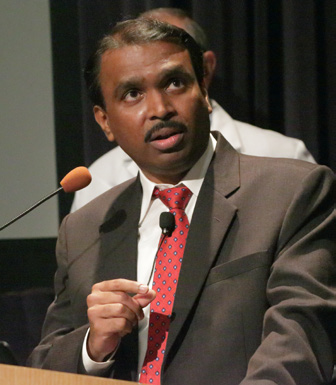 |
Dr. Ranhanath Muniyappa, the 2014 Distinguished Clinical Teacher Award recipient. |
The Clinical Center hosted the Twelfth Annual John Laws Decker Memorial Lecture in June, featuring Dr. Ranganath Muniyappa, the 2014 recipient of the Distinguished Clinical Teacher Award.
Each fall the NIH clinical fellows choose a highly regarded mentor to receive the Distinguished Clinical Teacher Award who delivers the Decker Memorial Lecture the following June.
The lecture honors the legacy of Dr. John Decker, who served as Clinical Center director from 1983 to 1990. Major advances occurred during Decker's tenure as Clinical Center director including marshalling of resources in support of AIDS research, developing the hospital's positron emission tomography program and implementing the clinical use of magnetic resonance imaging.
Muniyappa, a staff clinician in the Clinical Endocrinology Section of the Diabetes, Endocrinology, and Obesity Branch, is also chief of the Inpatient Diabetes Consult Service at the National Institute of Diabetes, Digestive, and Kidney Diseases (NIDDK). He researches the metabolic and vascular actions of insulin and how these actions are impaired in insulin-resistant states such as obesity and diabetes. Muniyappa also focuses on understanding the physiologic basis for the higher prevalence of cardiovascular dysfunction and insulin resistance in ethnic minorities such as African-Americans, Hispanic/Latinos and Asians.
Muniyappa's presentation, "Impact of Selective Insulin Resistance on Cardiovascular Risk Reduction Strategies", centered on the relationship between insulin resistance and cardiovascular risk.
Insulin normally helps regulate blood sugar levels by controlling how much glucose, or sugar, is passed from the bloodstream into the body's cells to be used as energy. In patients with insulin resistance, the cells in the body are unable to use insulin as effectively, leading to high blood sugar.
Insulin resistance is associated with coronary plaque vulnerability, a situation where plaques build up in the arteries supplying the heart muscle. Typically the endothelial layer of blood vessels is anti-inflammatory (reducing inflammation) and anti-coagulant (preventing blood clots). However, endothelial injury due to hypertension (high blood pressure), dyslipidemia (an abnormally high amount of cholesterol and/or fat in the blood), hyperglycemia (an excess of glucose in the bloodstream) or hyperinsulinemia (excess levels of insulin circulating in the blood) recruits monocytes, a type of white blood cell that aids in plaque formation.
Muniyappa outlined several other potentially negative health outcomes, including vasoconstriction, or the narrowing of blood vessels; reduced capillary recruitment in the skeletal muscle; and increased rates of macrovascular diseases, afflictions of larger blood vessels like the coronary arteries and carotid arteries in the neck.
The connection between insulin resistance and cardiovascular disease is striking: "Diabetes increases the risk of developing macrovascular complications by two-fold," stated Muniyappa.
While the health implications are important, so are the economic impacts. "The cost of diabetes care in the U.S. grew from $98 billion in the mid-1990s to $245 billion in 2012. That's roughly equal to the combined state budgets of New York and California," stated Muniyappa.
Employees participate in Take a Hike Day event on campus
Despite the pervasive rain in the morning, nearly 1,400 people attended Take a Hike Day at NIH June 4. David Ram (photo center), from the Clinical Center Biomedical Engineering and Personal Property Management section, along with 84 other members of the Clinical Center enjoyed the 3.25 mile walk/run around the perimeter of the NIH campus. The event was sponsored by the NIH Office of Management and the NIH Recreation and Welfare Association. Over 11,000 employees have participated in the past seven walk/run events at NIH, each with representation from all 27 NIH Institutes and Centers. |
Volunteers needed for clinical trials on asthma, taste, vascular health
National Heart, Lung, and Blood Institute
Do you have asthma? NHLBI is seeking volunteers with asthma for a study that would require two outpatient visits and one inpatient stay at the NIH Clinical Center. Compensation may be provided. (Study #99-H-0076)
National Institute on Deafness and Other Communication Disorders
NIDCD seeks healthy adults for a research study at NIH on the role of our genes in how we perceive taste. It would require one to two study visits, each about 30 minutes. Compensation is provided. (Study #01-DC-0230)
National Institute of Nursing Research
Healthy older adults ages 55-75 are invited to participate in an outpatient research study investigating the benefits of omega-3 oil and blackcurrant supplements on vascular health. The goal of the study is to determine whether the supplements improve blood flow and blood vessel function, which can affect your heart. Eligible participants must be medication-free and in good general health. The study will be carried out in an outpatient clinic and includes four visits over six months. Compensation is provided. (Study #14-NR-0034)
More information on the studies above or others available, call the NIH Office of Patient Recruitment 1-866- 444-2214, (TTY 1-866- 411-1010) or visit www.clinicaltrials.gov.
Upcoming Events
Most lectures will be streamed live and archived
Clinical Center Grand Rounds Lecture: Contemporary Issues in Graduate Medical Education
Human Research Protections Beyond the Institutional Review Board; Unmasking the Ramifications of Data "Fudging" in Human Research Studies
August 5, 2015, Noon – 1:00 p.m.
Lipsett Amphitheater
Presented by Kristen Grace MD, Office of Research Integrity, Division of Investigative Oversight, Department of Health and Human Services
Clinical Center Grand Rounds Lecture: Contemporary Issues in Graduate Medical Education
The Current Reality of Competency-based Medical Education
August 12, 2015, Noon – 1:00 p.m.
Lipsett Amphitheater
Presented by William F. Iobst, MD, The Commonwealth Medical College
Clinical Center Grand Rounds Lecture: Contemporary Issues in Graduate Medical Education
The Clinical Environment as a Learning Environment: The Accreditation Council for Graduate Medical Education, Clinical Learning Environment Program
August 19, 2015, Noon – 1:00 p.m.
Lipsett Amphitheater
Presented by Carl Patow, MD, Accreditation Council for Graduate Medical Education,
Clinical Learning Environment Program, Virginia Commonwealth University
Clinical Center Grand Rounds Lecture: Contemporary Issues in Graduate Medical Education
Risk-Benefit Analysis in Clinical Research: What is the Role of Equipoise?
August 26, 2015, Noon – 1:00 p.m.
Lipsett Amphitheater
Presented by Scott Kim, MD, NIH Clinical Center
NOTE: PDF documents require the free Adobe Reader.
 The information on this page is archived and provided for reference purposes only.
The information on this page is archived and provided for reference purposes only.
